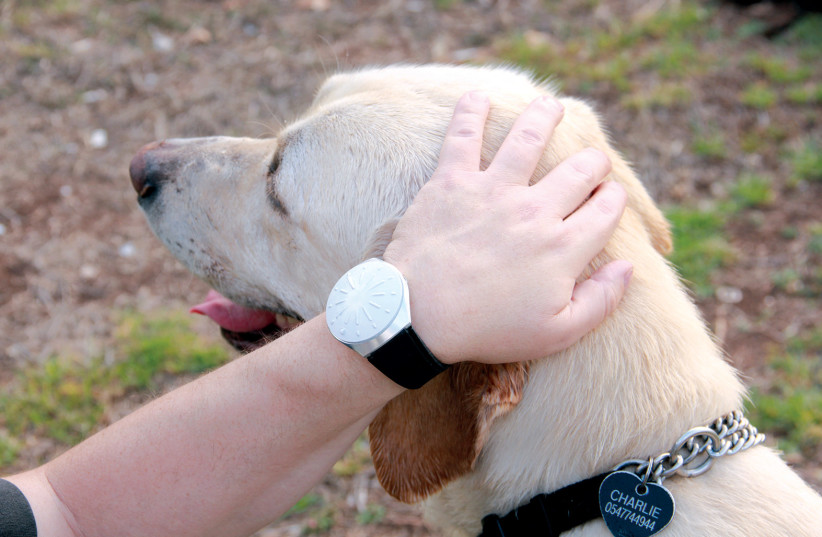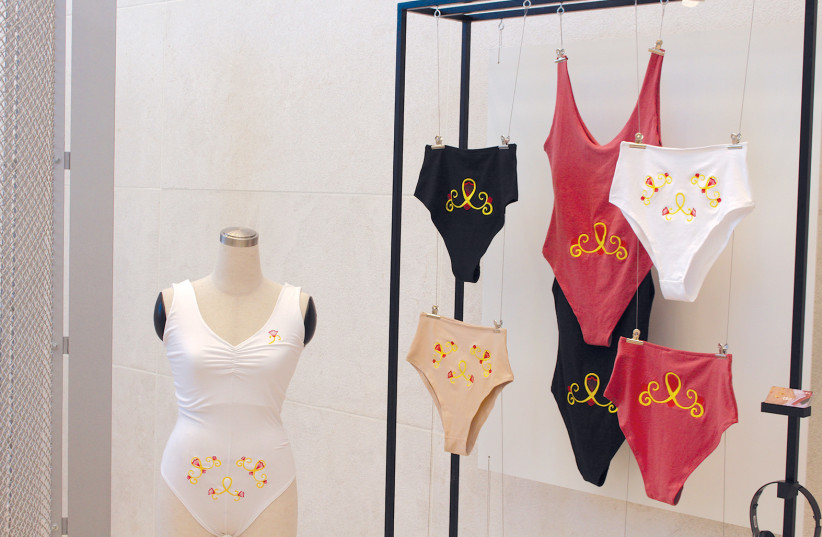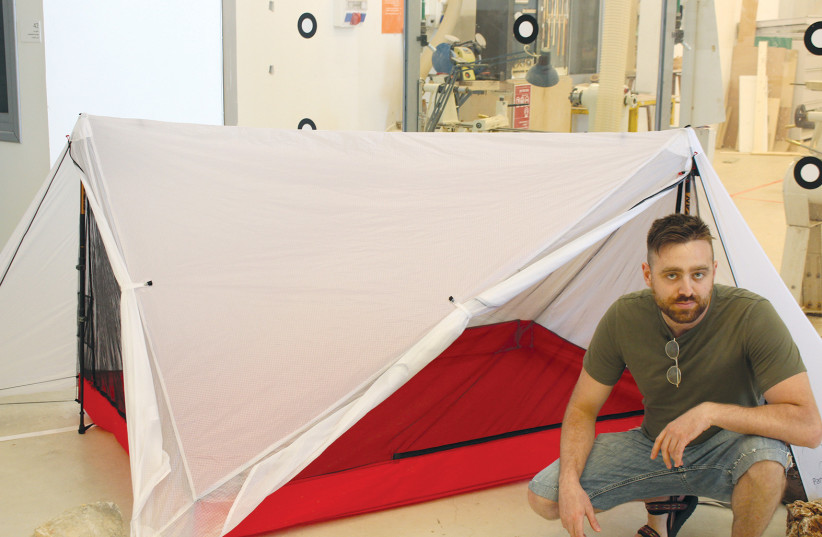From flying defibrillators to biodegradable toilet paper, the young geniuses at the Bezalel Academy of Arts and Design are displaying their final projects to the public at the Bezalel Graduate Exhibition, from August 3-18, at the academy’s new campus in the historic Russian Compound area of Jerusalem.
Boris Shatz, who founded the school in 1906, would be proud of the new facility and the students. Prof. Ido Bruno, who is in charge of final projects at Bezalel certainly is. The former director of the Israel Museum expressed the school’s excitement over the new building and its more than 400 graduates, with 40 students from the Industrial Design Department.
“The final projects are initiated by each student,” he said. The four-year bachelor’s degree covers a variety of studies, but the final project, which takes the entire final academic year, is something unique, he added. “They study in the field, build models and mock-ups. Each project is presented to a panel to receive feedback before display to the general public.
“You will find themes and subjects that are highly relevant in contemporary society,” Bruno stated. “Some relate to issues of sustainability and environmental impact, and there are projects that respond to the political issues happening in the country.”
Material left over from the current nationwide protests served as inspiration. One student developed a series of chairs made from unused police barricade fences found at festivals and protests. Another student created musical instruments/noisemakers from plastic bottles and other materials left after protests.

One project was innovative outdoor furniture intended for use at the new campus. Yet another was a floating race car that uses magnets, estimated to be a reality by the year 2048.
Bruno teaches a first-year basic course in industrial design to guide the students through the first steps of manufacturing methods and materials, and a third-year course on medical innovations. For example, this year the students visited the EEG unit of Hadassah Medical Center and heard lectures by professionals on EEG readings for people with epilepsy and other types of neuropathologies.
Bruno also manages the final projects. “Five of my students have done projects about sustainability, saving fruit and vegetables, a special kit to build homes for wild bees, and the reuse of clothing,” he said proudly.
Another student designed a “Bli Ayin Hara” ceremony against the evil eye, based on her Jewish-Egyptian family roots. “She studied a ceremony that her great-grandmother from Egypt performed, which she redesigned, keeping most of the features but in a new environment,” Bruno said.
Born and raised in Jerusalem, Bruno graduated from Bezalel’s Industrial Design Department in 1992 and returned to teach two years later. He spent 2017-2021 as the director of the Israel Museum, something that also has its roots in the school.
He explained that while “Bezalel was initiated 117 years ago by Boris Shatz – a visionary, dreamer, art professor, and accomplished artist who came to Jerusalem with a dream of art and design but also a museum – ” the Israel Museum “is actually the manifestation and evolution of Boris Shatz’s dream of creating a museum in Jerusalem.”
Bruno’s roots at Bezalel go back to his great-uncle, the noted painter Samuel Hirszenberg.
“Shatz invited him in 1907, and he taught at Bezalel. My mother studied jewelry there in the 1960s. My sister studied there in the 1980s, and my sister’s son is now studying in the Industrial Design Department. So it’s four generations now.”
Bruno estimates that the majority of the country’s creative community, whether in art or design, have either studied or taught at Bezalel or have some connection to it.
The historic Bezalel building where Shatz once taught still stands on Bezalel Street. It now houses only the Architecture Department. Until this year, most of the other departments were housed on the Hebrew University of Jerusalem campus.
“Our greatest asset is our students,” Bruno said. “We usually say that students learn about 80% from their peers and 20% from their teachers.”
At a special press event for journalists at last week’s opening event, students supported each other rather than competing for attention, and were eager to promote each other’s projects.
Innovative practical ideas
Graduate student Rafael Amzallag traveled the world after his IDF service. His experience in backpacking and trekking led him to create an ultra-lightweight and compact two-person tent using hiking poles
“I’m kind of a big guy,” Amzallag said, “so I like to have my space inside a tent and not have it be cramped and small.”
There are only two tent poles, and they double as walking sticks. The goal was to create the most comfortable tent weighing the least amount, he explained. “It’s the largest and lightest tent in its category, weighing under a kilo, 872 grams, including the stakes,” he said.
“During the day, you walk with your hiking sticks, and then use them for the base construction of the tent. If you have two tents, you can merge them to create a shared space,” he said.
For first-timers, the tent takes about four minutes to erect, but once you are familiar with the process, it can take less than a minute. There are also magnetic snaps and flaps to make the tent user-friendly and wind-proof.
“Bezalel taught me how to take an idea and find if it’s relevant for the real world and how to create a real functioning product,” Amzallag explained.
Saving lives
Arad Rubinovitch trained for earthquake rescue while in the IDF search and rescue unit. Her project is a backpack system that contains all the necessary equipment in convenient, easy-to access compartments.
“It’s really simple tools,” she said, not items that require a lot of guidance. Although rescue systems are already in place, Rubinovitch thought her backpack would streamline them. “After an earthquake, there is so much chaos, and I wanted to find a solution,” she said.
The backpack contains a walkie-talkie, pick ax, and other tools for breaking, removing, lifting, and more.
Despite all her training, Rubinovitch never actually participated in an earthquake rescue operation, but the training she got in the IDF has stayed with her ever since. “A lot of us go through life and we practice and practice and sometimes we are in real events, but a lot of time we are just practicing and that’s okay,” she said. “It’s also important to give over the information to other people as much as possible.”
Personal struggles turned into products
Many of the projects in the Industrial Design Department came from personal experiences. Ran Shtub created AirPulse, a defibrillator that can be delivered by UAV to someone having a heart attack in a remote area.
The idea came from the tragic loss of Shtub’s father, who died of a heart attack in 2004 while bicycling in the Jerusalem Hills region. The amount of time it took for an ambulance to reach his father was too long to be able to save him. But with Shtub’s design, a defibrillator could reach a person in about two and a half minutes.
“It flies like a long-range missile,” Shtub said, “and is able to land as a multi-rotor drone with a precise soft landing.”
The graduate student explained that the first five minutes of a heart attack are the most critical. “We will be able to save 70% of the people who have heart attacks,” he estimated.
AirPulse is connected to GPS, so a fellow hiker or bicyclist can drop a pin, and the paramedics can send the defibrillator to be easily applied to the victim’s body until professional help arrives.
Shtub worked with an aeronautical engineer from the Technion-Israel Institute of Technology to develop the lightweight device and designed it using 3D modeling software.

Endometriosis
Maayan Cohen Bar-On struggled through her four years of classes at Bezalel suffering from endometriosis, a chronic disease that affects one in 10 women. Her final project was a line of smart underwear made with e-textile. The disease is difficult to diagnose, so the underwear can help identify symptoms and also has heating pads to alleviate pain.
Cohen Bar-On designed and sewed the clothing decorated with yellow and red flower shapes, which resemble what the disease looks like under a microscope and the yellow ribbon symbol representing endometriosis awareness.
“It took 15 years to diagnose me, so it’s my biggest victory,” she said. “I have a lot of pain, so I especially wanted to do something good from my bad experience.”
In her research, she spoke to doctors and studied different types of feminine undergarment products. “That’s how I chose the fabrics and the technology in it,” she explained.
“I’m from Jerusalem, so all of my life I’ve heard about Bezalel, and I’m very happy to finish in this new, beautiful building,” Cohen Bar-On stated.
E-Steem nightgowns
Another clothing design was E-Steem, a series of nightgowns created by Deborah Hoffnung, intended for cancer survivors who have undergone a mastectomy. “It’s very hard for them to look at themselves and to deal with this new body,” she explained. The clothing uses hi-tech fabric to create “a calm mindfulness sensation about her own body after treatment, “ she said.
Hi-tech solutions
Hye Seo Chang developed her project based on seeing parents struggling to get small children – who were afraid of the dark and of monsters under the bed – to sleep. Her interactive AI sleeping companion, called Snuggles, is a combination baby-monitor and night-light that sing songs and reads books.
“It helps educate the child to fall asleep and adopt a natural, healthy sleeping pattern,” she explained. “It has a monitor for parents to know the status of the child as the child is falling asleep.” The parents have an app that vibrates and tells them if their child needs immediate help in case of an emergency.
The soft plush toy uses mirroring psychology, so when it’s bedtime the eyes close, prompting the child to close their eyes as well. “It reminded me of my own childhood; I also had a fear of darkness,” Chang said.
Chronoline watch for the blind
Yoni Zazon developed a watch for blind people called Chronoline. “You can become blind at any age from a variety of different reasons,” he said. “The watches that exist for the blind today are somewhat lacking in design and comfort. The most common watches are talking watches that are impractical if you try to use them in a very noisy environment or in a very quiet environment, like a meeting or an appointment,” Zazon said.
“There are several small servo-motors that push up and down lines; that way, you can just move your finger on top of the surface and you can literally feel the time as it goes by,” he explained. Zazon received feedback from people in various states of blindness to develop the most effective model.
Making marriage work
Shir Sharabi created a series of candles designed for couples therapy inspired by the book The Seven Principles for Making Marriage Work by Dr. John Gottman.
“A couple can light a candle during dinner or just in their living room in the evening and practice each principle,” Sharabi stated. Match in hand, she demonstrated a two-branched candle that is separated at the top but comes together at the bottom as the flames burn.
Another design is a cluster of separate small candles representing “all the good things that the partner is giving me. We have a lot of candles to remember to appreciate the little things,” she explained.
“I tried to show that objects can help us change our life,” Sharabi said. “If we have a different design, it will affect us differently. We choose colors, smell, the material, the scenario. And then we can change our life.”
Regarding her coursework, she added, “I’m glad to graduate. It was hard, but it was a great opportunity.”
‘Nereids’ in the ocean
In a side room was a display of tubes and beakers with coral behind blueish lights. Sunny Lustov explained her project in which she designed underwater structures intended to safeguard coral reefs. Naming them “nereids,” the structures provide active cooling for endangered areas. “They are made of a thermoresponsive, biocompatible hydrogel,” she said.
For the past two years she has been researching the gel at Hebrew University’s Racah Institute of Physics. “The unique thing is that it is biocompatible and used for human implants and tissues but never used for this. It changes its form as a response to temperature fluctuations,” she said.
Coral reefs are dying due to heat, Lustov explained, but placing nereids in the ocean could absorb more heat and help alleviate the problem.
Bezalel was not Lustov’s first choice, but a friend urged her to enroll because the education is more than just practical.
“It gives you a way to think. It broadened my view, thoughts, and imagination.”

Imagining the future
Dor Zerkavod created a spacesuit which he hopes one day will actually be put to use.
“It’s a simulating gravity suit for travel in deep space, in zero gravity,” he stated. “The concept of this project was born from my fascination with deep space travel and the idea that soon enough, humans will be venturing off into deeper space, and there are problems that zero gravity creates on the body because of the lack of gravity that we have here on Earth,” he said.
“Right now, space is secluded for very prestigious, highly trained individuals, and the whole concept of this project is to find the solutions to enable the body to withstand zero gravity so everyone can go into space,” he explained.
The form-fitting suit is displayed in front of a video depicting the bulky space suits of the 1960s. As Zerkavod stood next to his creation, he explained it was “a 3D knitted textile that is electro-active, which means that it gets an electric pulse and knows to contract and concede with a program.
“Surrounding the textile are pressure sensors and thermoelectric generators to enable the suit to capture body heat and transfer it into energy so the suit doesn’t need to be charged as much,” he said.
The suit is designed to be worn as much as possible so that there are fewer effects on the body, Zerkavod explained. “We put in special zippers for going to the bathroom which are very intuitive, so it’s very easy to get in and out of the suit.”
Zerkavod compared Bezalel to other schools he attended on semesters abroad. “Bezalel really admires students that try and break the rules and create things that no one has ever done before, and I love that I can do a conceptual, technology-based futuristic object.”
Toilet paper made from oranges
Avia Revivi designed biodegradable toilet paper made from oranges. It was the sight of discarded, used toilet paper during a visit to a nature park that motivated her to find a better way to go to the bathroom while hiking or camping. Her toilet paper substitute is called O-Sow, and her business card is printed on a rectangle of the material.
“I started to dry some vegetables and fruits to find the best material,” she said, “and I discovered that not everything is soft, flexible, or non-absorbent.”
After much trial and error, she used the inside of an orange, from which she could develop the right thickness and comfort. The toilet paper is also embedded with tiny seeds of other plants so that the human waste will fertilize these seeds, and plants will eventually grow on the spot where the orange toilet paper was used.
She hopes her experiments can also be used to develop biodegradable food packaging and for other potential uses.
Humor in challenging times
Not all the projects were serious. Some injected a sense of humor to provoke thought.
Chen Smadar created Keter Chair Martial Arts, an imaginary sport involving fighting with white plastic chairs. Ubiquitous in Israel are the plastic chairs manufactured by the Keter company, which can be found at beaches, synagogues, malls, and private homes.
Her inspiration came from reading news coverage of a brawl in which people threw chairs at each other. That prompted her to imagine a sport, similar to capoeira, the Brazilian dance form based on martial arts. Smadar designed a special uniform padding for the chair, and a point system, all detailed in a brochure explaining the fictional history of the sport.
Regarding the school’s new facility, Smadar, like most of her fellow graduates, praised it. “This is the first year that we are in the middle of the city center. I think Jerusalem is ‘a thing’ for us in the world and as Jews,” she said.
As designers and artists, Smadar believes that now she and her fellow graduates who are leaving the academic world “have a mission.”
“We can make money and try and survive in this reality, but I want to believe that it means a lot to be here in Israel, in this time, in Jerusalem,” she said. “We have a mission in this world to make it better.” ❖
